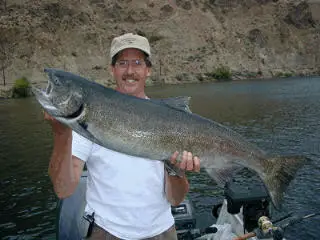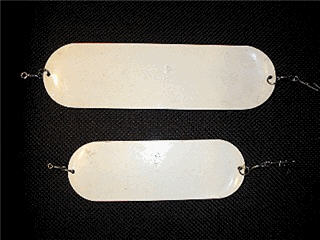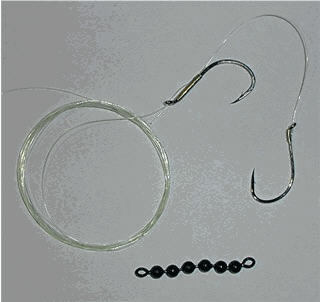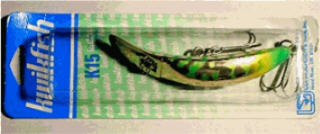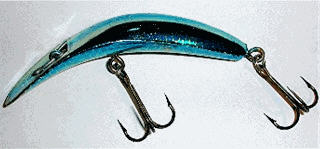Search
Latest Articles
Tackle Basics for Summer-Run Salmon
by Dave Graybill, August 01, 2004
Here’s my brother Rick with a dandy!

One of the "hot spots" for seeking out summer runs is at the mouth of the Okanogan River near Brewster, and this year there were estimates of over 200 boats crowding the waters here on the opener. There is a Salmon Derby run through the Brewster Triangle Shell Food Mart, and for the fourth year there will hundreds of salmon weighed-in for weekly cash prizes and lots of merchandize.
This kind of attention to a salmon fishery in this area is a new development. As many as 50,000 summer runs may be available to anglers in a season that starts in mid-July and runs through mid-October. The fish that won the Derby last year weighed over 40 pounds, and several over 30 have already been turned in this season. No wonder anglers are making their way to the small town of Brewster to get in on this kind of action!
Fishing isn’t limited to the mouth of the Okanogan. Lot of fish are taken on the Columbia in the vicinity of the city of Wenatchee, and another very popular fishing area is below Wells Dam, which is between Lake Chelan and the town of Brewster.
There is some bank fishing opportunity for anglers below Wells Dam, but for the most part fishing for summer runs requires a boat and motor. I was impressed this season to see how many boats are outfitted with downriggers now. When this fishery first took off not every boat was so equipped. To see a boat without downriggers on the water after salmon here is a very rare site today.
What anglers hook to those downriggers may vary from boat to boat and from day to day depending on the bite. There are a few essentials that most all anglers would agree that should be in any fisher’s arsenal when in pursuit of upper Columbia summer-run salmon.
Not always, but most often anglers will put at least 25 to 30 feet of line out behind the boat before attaching it to the downrigger. A 20 to 25-pound main line and leader is sufficient, particularly if an angler is running straight herring. Few up here do, though, and some use a 30-pound leader to their dodger.
Show here is a size 1 and "0" Dodger.

It may seem odd to run dodgers in a river, but in many of the more popular areas the flows are so slow that they appear to be an advantage. Anglers may want to experiment with leader length behind the dodger. They should be short enough to impart action to the bait. If they’re six feet long they don’t have any effect on the action of the herring.
Cut-plug herring are the bait of preference. I’m not saying other baits don’t work, and I’ll mention some later. The vast majority of salmon that are taken on the river will be taken on herring. If you don’t know how to cut a herring to get a nice tight spin, there are some devices on the market that work as sort of a miter box or cutting guide. A herring that doesn’t spin properly is a waste of time, and don’t underestimate the importance of a bait that works properly.
There are a couple of different ways of rigging a herring, but they require a double hook leader. Some tie a "slider" so they can adjust the space of the hook
Here is a typical double hook leader, note beaded chain

to the size of the bait, too. Always add a beaded chain swivel to your herring leader. These baits spin and can easily twist a line. Hook sizes of 2/0 to 4/0 are fine for this fishery. Once you have "cut your plug" you may want to run the bottom or trailing hook through the side of the herring. Put the top hook next to the backbone of the herring. Always test your herring for spin before running it out. I always add some of my brother Rick’s "Secret Sauce" (Graybill’s Guide Formula) scent to the bait, too.
Now my rig is ready to go and now I need to determine how deep to run it down on the rigger. Much of the time while fishing off the mouth of the Okanogan anglers are in 30 to 40 feet of water and they run their baits down to 15 to 25 feet. I recently fished another area of the Columbia, and although we were in 60 to 80 feet of water, we got all our fish on baits set at 25 feet!
What I have described above is a very brief sketch of what is required to troll for salmon in the calmer waters found along the Columbia. There are times when currents make this difficult if not impossible. There are also anglers who simply prefer to back troll. They know the slots and shallower runs and present their baits by backing down to the fish.
An example of a Jet Diver

It is important to keep baits in the strike zone when back trolling and this made possible through the use of a Jet Diver. These divers use the current to drive the bait to the bottom. Herring can be used as a bait behind a diver, but often currents are strong enough to tear the bait and plugs are preferred.
There are a variety to plugs and lures that can be presented in this manner, but a couple that have proven to be very deadly are the M-2 Flatfish and K-15 Kwikfish. Sometimes the same lures in a size or two smaller can be effective, but if you’re going shopping, get these sizes first. There are a bunch of colors to try, too.
Here’s an M-2 on the top, K-15 below


Later in the season, fresh roe can be an outstanding bait. Bank fishers use it to great effect, and back trolling roe is a great way to present this bait to summer-run kings hanging near the bottom.
These are just a few pointers on what to have in your tackle box when in search of summer-run Chinook on the upper Columbia. There are many refinements on fishing these baits and others. One good way to save hundreds of hours on the water learning how to use all this stuff is to go out with a good guide. You’ll save a lot of time and money "going to school" on a guide.
The one I would recommend for upper Columbia fishing is Rod Hammons of R & R Guide Service. He works out of the Brewster area, and you can find his web site by logging onto FishingMagician.com and going to my Links Page. Look under Guide Services. You can also call Rod at (509) 689-2849.
Although hundreds of summer-runs have already been landed this year, the season is just getting started. There are lots more fish on the way up the river to the Brewster area.
Battling big kings under sunny skies in largely uncrowded conditions is something any angler can appreciate, and making a trip over here to experience it would an adventure with life-long memories in the making.
